Thank you, Edmond! Very interesting and I stand corrected. So both the original method network and Sandy's sketch work, albeit with different expressions for the notch frequency.
Using the "virtual ground" analysis on the original network, each arm has radian corner frequency of 1/(2 Pi RC) radians/s = 1/(4 Pi RC) Hz.
Thanks again.
Using the "virtual ground" analysis on the original network, each arm has radian corner frequency of 1/(2 Pi RC) radians/s = 1/(4 Pi RC) Hz.
Thanks again.
Make sure that the equipment which drives the passive filter input, has a very low output impedance. I'd recommend Zout_driver <= (R / 50) where R is the smallest resistor in the filter circuit.
Also make sure that the equipment which is driven by the passive filter output, has a very high input impedance. I'd recommend Zin_receiver >= (R * 50) where R is the smallest resistor in the filter circuit.
Otherwise you'll inadvertently reduce the notch depth and change its center frequency.
Of course these restrictions disappear if you use an active filter instead of a passive filter. Think of them as the "cost" of insisting upon all passive.
Also make sure that the equipment which is driven by the passive filter output, has a very high input impedance. I'd recommend Zin_receiver >= (R * 50) where R is the smallest resistor in the filter circuit.
Otherwise you'll inadvertently reduce the notch depth and change its center frequency.
Of course these restrictions disappear if you use an active filter instead of a passive filter. Think of them as the "cost" of insisting upon all passive.
Sure. You finally discovered that too. Better late than never.Едно и също е.
Is that so?Просто човек е по-удобен за използване
BTW: Posting in a language other than English without a translation is not allowed (see terms and rules).
No.[...]
Also make sure that the equipment which is driven by the passive filter output, has a very high input impedance. I'd recommend Zin_receiver >= (R * 50) where R is the smallest resistor in the filter circuit.
Otherwise you'll inadvertently reduce the notch depth and change its center frequency.
[...]
I've been experimenting with this Hall type notch filter as described in THIS ARTICLE. I duplicated the circuit in figure 6. on breadboard. Why is my output leading to the notch~40 dB down from what I expected?
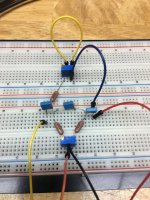

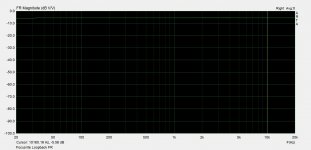
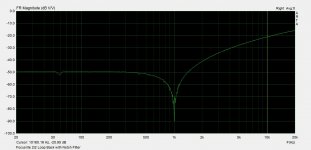




Here is the simulation of your Hall network for two impedances of the ADC inputs - 600 kOhm (instrument input) and 3 kOhm (mic input).I've been experimenting with this Hall type notch filter as described in THIS ARTICLE. I duplicated the circuit in figure 6. on breadboard. Why is my output leading to the notch~40 dB down from what I expected?
Martin
Attachments
Last edited:
With the input of the Focusrite set to MIC I'm getting the FR as simulated above. However, when I do a 1k loopback with the notch filter in the circuit the spectrum analyzer shows a spike at 60Hz and all of it's harmonics. There is no connection to 60Hz AC mains, so where could this distortion be coming from?
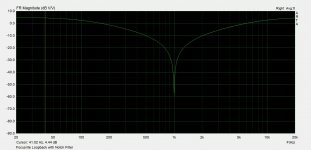
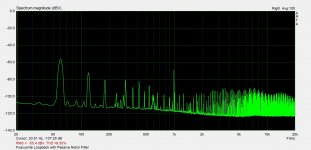


The room is full of it, even if not wire-connected.spike at 60Hz and all of it's harmonics. There is no connection to 60Hz AC mains
Bring it to my back yard, a mile back. Or a mile the other side of George's. The 60Hz hash will be far less.
It looks like ground loop noise/hum.With the input of the Focusrite set to MIC I'm getting the FR as simulated above. However, when I do a 1k loopback with the notch filter in the circuit the spectrum analyzer shows a spike at 60Hz and all of it's harmonics. There is no connection to 60Hz AC mains, so where could this distortion be coming from?
View attachment 1127102View attachment 1127103
You can try to disconnect GND (shielding) from notch filter in one of your cables - their GNDs are connected in your Focusrite already and acts as antenna loop to pick-up the hum and noise.
Martin
- Home
- Design & Build
- Equipment & Tools
- 1 kHz passive notch filter
